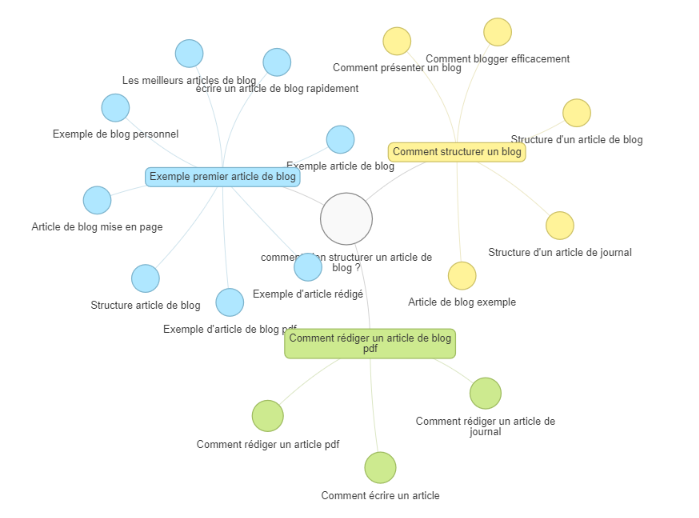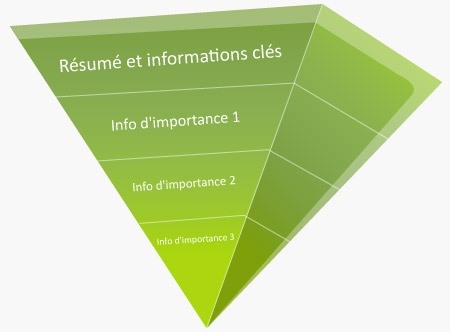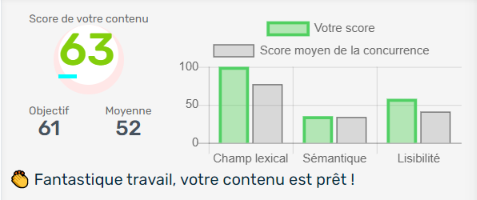Do you spend hours perfecting your blog content without achieving satisfactory results? It's not inevitable! Be aware that for a text to appeal to your readers and rank well on Google, it must be thoughtfully constructed! But how do you properly structure a blog post? I'll share my tips and explain the 11 steps to follow to organize your next post like a pro!
🚀 Quick read: How to structure a blog post in 11 steps
Here's a summary of the 11 steps to properly structure a blog post! This won't replace a web copywriting course, but you'll have all the guidance you need to structure a text that meets the needs of both users and search engines.
- Choose the right topics
- Find the keywords
- Know your audience
- Research reliable sources of inspiration
- Create a writing plan
- Write the blog post
- Optimize the content
- Add media
- Include internal and external links
- Fill in the metadata
- Proofread your content
❓ Why should you structure a blog post?

Bloggers can easily be divided into two categories! Some simply want to share their views or experiences. Others want to attract organic traffic and captivate their readers. If you belong to the latter category, you probably want to know how to properly structure a blog post!
Indeed, the structure of your blog post is crucial for achieving your goals. It allows you to:
- quickly respond to search intent;
- decrease the bounce rate;
- maintain your visitor's interest;
- improve your conversion rate;
- meet Google's ranking criteria;
- increase your visibility on search engines;
- grow your SEO traffic.
But how do you write a blog post that achieves all these results? Contrary to popular belief, it's not enough to dive headfirst into writing your content! There's a preliminary work to be done and a specific way to proceed. Below, I invite you to discover the 11 steps I use to properly structure a blog post.
💥 11 steps to properly structure a blog post

Here, I share with you my approach to writing an SEO-friendly blog post. Before I even start writing, I take the time to do a preliminary analysis. Then, I write following a specific methodology. Finally, I take care of the natural SEO optimization. Here are the 11 steps I follow to structure a blog post!
1. Choose the right topics
To choose the right themes, consider two factors: your area of expertise and your target reader. Indeed, your goal is to prove to Google that you are an unrivaled specialist in your sector and that your expertise is comprehensive on a specific topic. Additionally, you want to meet the needs and expectations of your readership.
To do this, I start by thinking about all the topics that correspond to the website I'm working on. If you're short on inspiration, don't hesitate to draw from your SEO competition! Then, I search Google for related searches and other questions asked. Finally, I use the SEOQuantum tool to establish an effective keyword clustering strategy.

After completing this analysis, you can gather all this information in a content calendar. This way, you can organize your upcoming actions and structure your writing team's work. Note that you can also use our SEO tool to create this document.
2. Find the keywords
Now that you know the topics you'll cover in your upcoming blog posts, you need to conduct keyword research. To achieve this, you can use tools like Ubersuggest, SEMRush, or Ranxplorer. Additionally, it's helpful to draw inspiration from the Google SERP for ideas.
My advice is not to focus solely on high search volume keywords. Indeed, they are often extremely competitive. It will be difficult for you to rank your blog post on these challenging queries, especially if your website doesn't have a strong reputation. Don't hesitate to work on long-tail keywords and local queries to be visible on Google's first page.
When writing your blog post, try to focus on one keyword per text. However, if your content is comprehensive and well-optimized, it will likely appear for an entire group of related queries. Thus, even if you haven't targeted a keyword with a thousand monthly searches, you can still attract significant traffic through dozens of keywords searched only ten times per month.
3. Know your audience
Remember that you're writing for human beings, not indexing robots. It's essential to accurately define your target reader to tailor your writing to their profile. Before writing your first blog post, I recommend conducting a thorough analysis of your SEO persona.
Of course, your writing style should also match your brand image. That's why it's highly recommended to establish an editorial line. You can then share it with your entire writing team to harmonize communication on your blog.
By doing so, you increase your chances of engaging your reader, retaining your traffic, and improving your conversion rate. Once these first three steps are completed, you can finally start writing your blog post!
4. Research reliable sources of inspiration
You have your keyword in mind and are ready to write your content. You may be very familiar with your subject and not need inspiration. However, it's always helpful to know what Google considers relevant.
I suggest browsing search engines to understand search intent and see how your competitors have structured their content. This will also help you complete the next step, which is creating a writing plan.
Moreover, to have a chance of ranking your blog post in the top position, you must outperform your competitors. Therefore, take the time to find reliable sources before writing your first line. To determine if they're reliable, you can:
- check the reputation of the site (with Majestic SEO or Ahref);
- verify the presence of legal notices and terms and conditions (often in the footer);
- ensure the writer is recognized in the field covered (a quick LinkedIn search is a good way to do this);
- quickly browse the entire blog to see if the topics are relevant to your subject;
- see if the site appears on related searches.
5. Create a writing plan
Creating a writing plan before writing is essential. Be aware that this plan is not rigid and may need to be revised during your writing process. However, it helps structure the information and ensures you cover the entire subject.
5.1 Title (H1)
Choose a title that briefly describes the topic covered in your blog post. It should offer a solution to the user's intent, and your content should fulfill this promise. Personally, to ensure the relevance of the title, I finalize it only after completing the writing of my text.
5.2 Introduction (lead)
This is the hook of your blog that will encourage your visitor to continue reading. For optimal results, I recommend exposing a problem the reader can identify with and presenting the solutions offered in the rest of the article. Once again, I refine this element only after finishing my article.
5.3 Subheadings (H2, H3, etc.)
Subheadings are essential for ensuring the comprehensiveness of your content. They are also crucial for facilitating skimming, a common habit on the internet. Dividing your text into subcategories ensures you cover the entire subject and significantly speeds up the writing process.
5.4 Conclusion
This is the last impression you leave on your reader, so it's important to take care of it! The conclusion typically summarizes the content covered in your blog post before suggesting a broader topic, a call to action (CTA), or an optimal solution to meet the user's needs.
6. Write the blog post
All the elements are now in place to write a blog post under the best conditions. I like to let my fingers flow on the keyboard and write my content without worrying about optimization. I write as ideas come to me, drawing inspiration from the previously selected sources.
Keep in mind that to properly structure a blog post, it's crucial to quickly address the promise made in your title. To do this, we use a technique called the inverted pyramid. The main content should be divided into paragraphs that follow this structure.

7. Optimize the content
Once your blog post is complete, I recommend performing an optimization score check. First, ensure the readability of your content. To optimize it, you can shorten your sentences (maximum 20 words) and space out your text.
Secondly, check if the lexical field is well-developed and if the semantics are good. To perform this task, I invite you to use our semantic analysis tool.

Finally, verify that your main keyword is present in the H1 title, the introduction, and the body of the text. Also, place it in some of your subheadings and add some synonyms or equivalents to vary the information and avoid over-optimizing your blog post.
8. Add media
Media helps illustrate your points, rest the reader's eyes, and add information to your content. Don't hesitate to add some of the following elements to your blog post:
- photos;
- infographics;
- videos;
- podcasts.
For SEO optimization of your images, consider the format (JPEG, PNG, or WebP), their size (maximum 1,280 px), their weight (maximum 100 KB), and their alt attribute (place a keyword in it!)
9. Include internal and external links
Internal linking is an absolutely essential factor for improving your natural SEO. When structuring a blog post, consider offering relevant internal links to complement the information you provide. This will please both your reader and Google, so don't hold back!
Similarly, external links are also beneficial for your SEO. To add value to your content, don't hesitate to mention reliable sources and high-quality content. A little tip: to avoid losing your traffic, make sure to force these links to open in a new tab!
10. Fill in the metadata
Metadata refers to the information displayed on search engine results pages. You should carefully craft this information to entice users to discover your content and improve your click-through rate.
10.1 Meta title
The meta title (Title tag
10.2 Meta description
Although the meta description has no direct influence on SEO, it remains an important factor that you should not neglect. This brief summary allows the Googler to quickly understand the relevance of the displayed result.
11. Proofread your content
Proofread your content before publishing your blog post! For a quick and efficient review, I follow this process: I first read aloud, then use an automatic reading tool. This way, I easily find typos while ensuring the layout of my post.
For correcting spelling, grammar, and syntax, I use a paid tool: Antidote. You can also use the free extension " LanguageTool" on your browser. Although it's not perfect, it's very handy for finding typos.
By following these 11 steps, you'll be sure not to miss any elements when creating your next blog post. Remember that this is done in four distinct phases: research, writing, optimization, and review. With this methodology, you'll be able to write faster and improve the ranking of your articles on search engines.
Before starting your reading, you wondered how to properly structure a blog post. Do you think you have all the information to start right away? Have you learned new techniques? Or do you know other tips for writing a high-performing article?
If you want to use an example to write your next content, don't hesitate to read this content: SEO article example: analysis of a concrete case.
Need to go further?
If you need to delve deeper into the topic, the editorial team recommends the following 5 contents:

